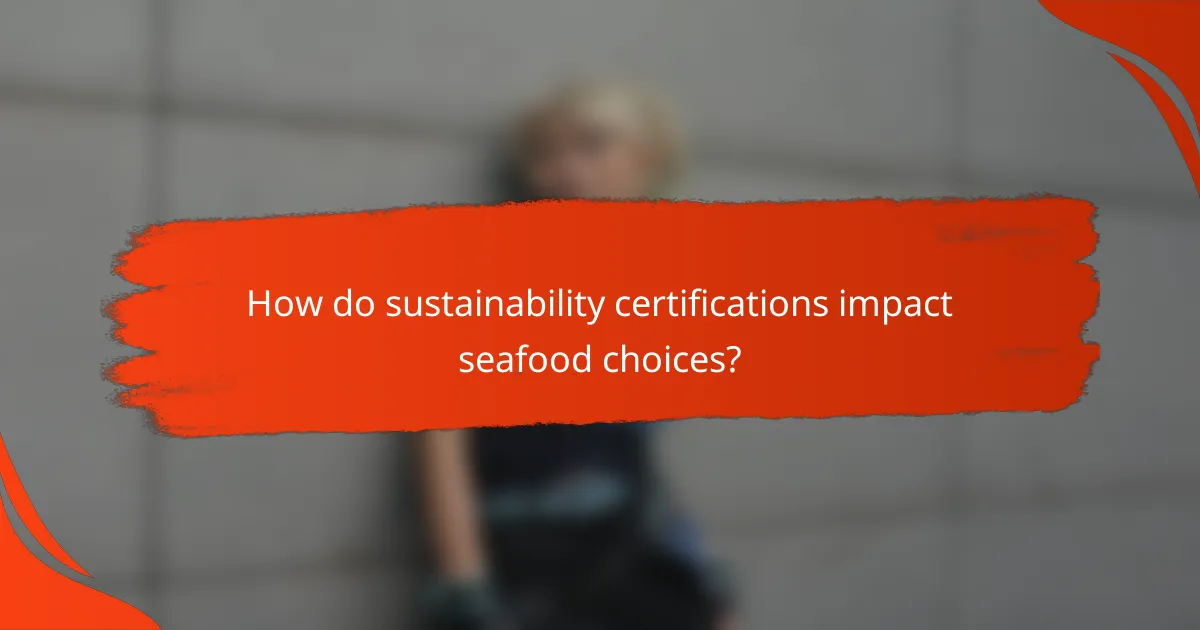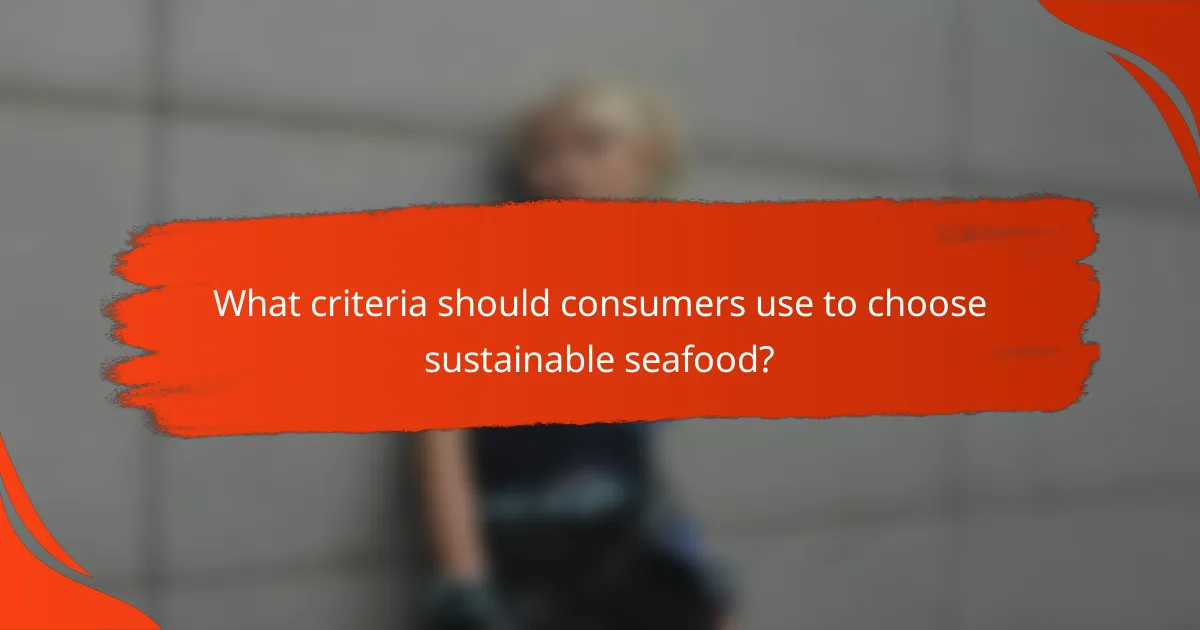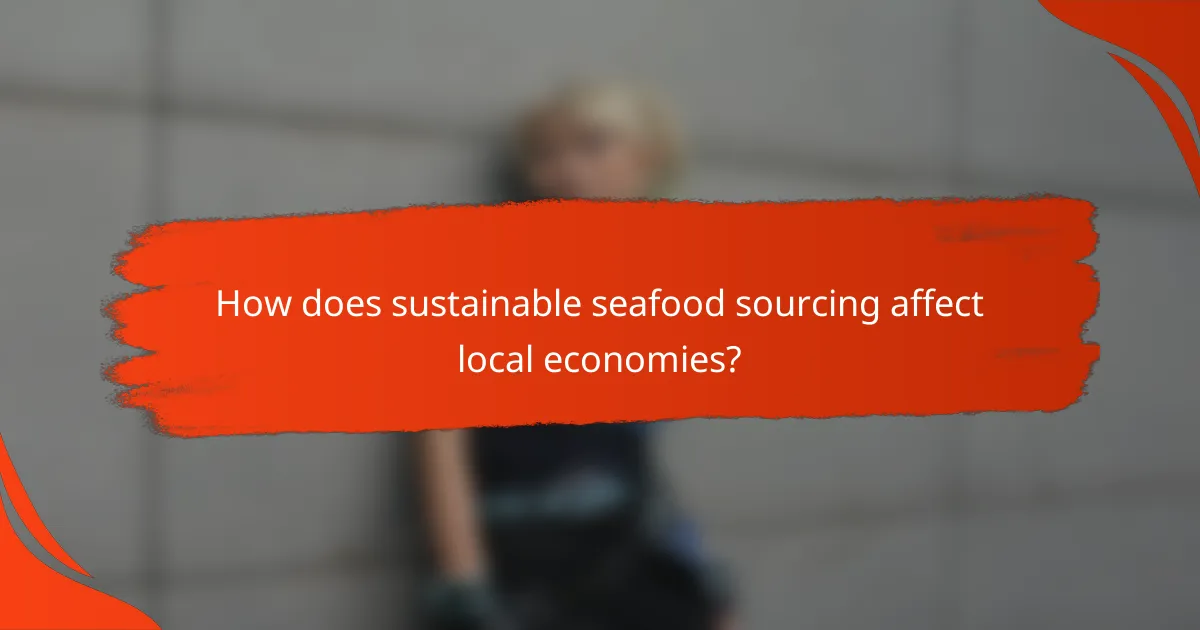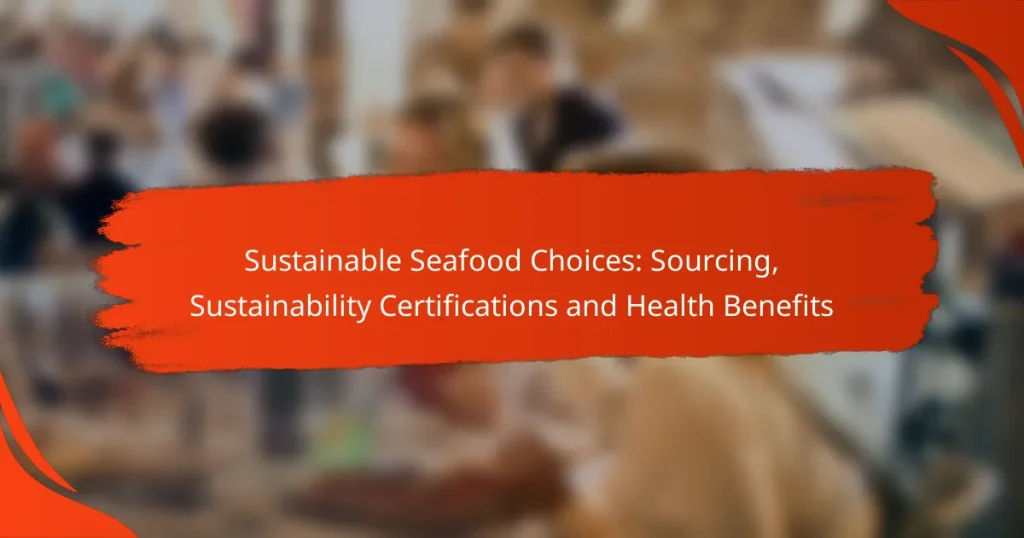Choosing sustainable seafood is essential for both personal health and environmental well-being. By selecting responsibly sourced options that meet recognized sustainability certifications, consumers can enjoy nutritious seafood while supporting healthy ecosystems. These choices not only provide numerous health benefits but also help minimize the environmental impact of fishing and farming practices.

What are the best sustainable seafood choices in the US?
The best sustainable seafood choices in the US include options that are responsibly sourced, have minimal environmental impact, and are certified by recognized sustainability standards. These choices not only support healthy ecosystems but also provide nutritious food options for consumers.
Wild-caught Alaskan salmon
Wild-caught Alaskan salmon is a top sustainable seafood choice due to its robust management practices and healthy population levels. The fish is caught in pristine waters and is often certified by organizations like the Marine Stewardship Council (MSC).
When purchasing, look for labels indicating it is wild-caught and check for sustainability certifications. This salmon is not only delicious but also rich in omega-3 fatty acids, making it a healthy option for your diet.
Farmed mussels
Farmed mussels are an excellent sustainable seafood option as they are often grown in environmentally friendly aquaculture systems. They require no feed, as they filter plankton from the water, which helps maintain water quality.
Choosing farmed mussels supports local economies and reduces overfishing pressures on wild populations. Look for certifications like the Best Aquaculture Practices (BAP) to ensure responsible farming practices.
Pacific sardines
Pacific sardines are a sustainable seafood choice due to their fast reproduction rates and healthy stock levels. They are typically caught using methods that minimize bycatch and habitat damage.
These small fish are nutrient-dense, providing high levels of omega-3 fatty acids and protein. When buying sardines, opt for those labeled as sustainably caught to support responsible fisheries.
U.S. farmed shrimp
U.S. farmed shrimp can be a sustainable option when sourced from responsible aquaculture operations. Look for shrimp that are certified by organizations like the Global Aquaculture Alliance (GAA) or the BAP.
These certifications ensure that the shrimp are farmed with minimal environmental impact and ethical practices. Avoid imported shrimp that may come from farms with poor environmental standards and labor practices.
Atlantic mackerel
Atlantic mackerel is considered a sustainable seafood choice due to effective management practices that maintain healthy populations. This fish is often caught using methods that have low environmental impact.
Rich in omega-3 fatty acids, Atlantic mackerel is not only a nutritious option but also versatile in cooking. When selecting mackerel, look for those that are certified by the MSC or other reputable organizations to ensure sustainability.

How do sustainability certifications impact seafood choices?
Sustainability certifications significantly influence seafood choices by providing consumers with reliable indicators of environmentally responsible sourcing. These certifications help identify seafood that is harvested or farmed in ways that minimize environmental impact and support healthy ecosystems.
Marine Stewardship Council (MSC) certification
The Marine Stewardship Council (MSC) certification is a globally recognized standard for sustainable wild-caught seafood. It ensures that fisheries are managed sustainably, maintaining fish populations and minimizing environmental impact. Products bearing the MSC label are traceable from ocean to plate, giving consumers confidence in their choices.
When selecting seafood, look for the MSC label to ensure that the fish comes from a certified sustainable source. This certification often applies to popular species like cod, tuna, and salmon, which are commonly found in grocery stores and restaurants.
Aquaculture Stewardship Council (ASC) certification
The Aquaculture Stewardship Council (ASC) certification focuses on responsible aquaculture practices. It addresses issues such as water quality, feed sourcing, and the welfare of farmed fish. The ASC label indicates that the seafood has been produced with minimal environmental impact and adheres to strict social responsibility standards.
Consumers can identify ASC-certified products in supermarkets, particularly for farmed species like shrimp, tilapia, and salmon. Choosing ASC-certified seafood supports sustainable farming practices and helps reduce the negative impacts of aquaculture on the environment.
Best Aquaculture Practices (BAP) certification
Best Aquaculture Practices (BAP) certification is a comprehensive program that covers various aspects of aquaculture, including environmental sustainability, social responsibility, and food safety. BAP certification is tiered, with different levels indicating compliance with specific standards, from hatchery to processing.
When shopping for seafood, look for the BAP logo, which can be found on products like shrimp, tilapia, and catfish. This certification not only assures consumers of sustainable practices but also promotes responsible farming and processing methods that benefit both the environment and local communities.

What are the health benefits of sustainable seafood?
Sustainable seafood offers numerous health benefits, primarily due to its nutritional profile and lower levels of harmful substances. Choosing seafood that is sourced responsibly can enhance your diet while supporting environmental health.
High in omega-3 fatty acids
Sustainable seafood is often rich in omega-3 fatty acids, which are essential for maintaining heart and brain health. These fatty acids help reduce inflammation and lower the risk of chronic diseases.
Fish such as salmon, mackerel, and sardines are excellent sources of omega-3s. Including these types of fish in your diet a couple of times a week can help you meet your nutritional needs.
Low in contaminants
Seafood sourced sustainably tends to have lower levels of harmful contaminants like mercury and PCBs. This is particularly important for vulnerable populations, such as pregnant women and young children, who may be more susceptible to the effects of these toxins.
By choosing certified sustainable seafood, you can minimize exposure to these harmful substances while still enjoying the nutritional benefits of fish.
Supports heart health
The consumption of sustainable seafood is linked to improved heart health due to its high omega-3 content and low levels of unhealthy fats. Regular intake can help lower blood pressure and reduce triglyceride levels.
Incorporating sustainable fish into your meals can be a heart-healthy choice. Aim for a variety of fish options to maximize benefits while enjoying diverse flavors and textures.

What criteria should consumers use to choose sustainable seafood?
Consumers should consider several key criteria when selecting sustainable seafood, including the source of the seafood, the fishing methods employed, and the overall environmental impact. These factors help ensure that seafood choices support healthy ecosystems and responsible fishing practices.
Source of seafood
The source of seafood refers to where and how the seafood is harvested or farmed. Wild-caught seafood from well-managed fisheries is often more sustainable than farmed options, especially if the farm uses environmentally friendly practices. Look for seafood sourced from regions with strong regulations and certifications, such as the Marine Stewardship Council (MSC) or the Aquaculture Stewardship Council (ASC).
Local seafood can also be a more sustainable choice, as it typically has a lower carbon footprint due to reduced transportation. Supporting local fisheries helps strengthen community economies and encourages responsible fishing practices.
Fishing methods
Fishing methods play a crucial role in determining the sustainability of seafood. Techniques such as trawling can cause significant damage to ocean habitats, while more selective methods like pole-and-line fishing tend to have less impact on non-target species. Consumers should seek seafood caught using sustainable methods that minimize bycatch and habitat destruction.
When possible, check for certifications that indicate responsible fishing practices, such as the MSC label. These certifications often require adherence to specific fishing methods that protect marine ecosystems.
Environmental impact
The environmental impact of seafood production encompasses factors like ecosystem health, carbon emissions, and resource use. Sustainable seafood choices should prioritize species that are abundant and not overfished, as well as farming practices that minimize pollution and resource depletion. For instance, shellfish farming generally has a lower environmental impact compared to finfish farming.
Consumers can also consider the carbon footprint associated with seafood. Choosing seafood that is in season and sourced locally can help reduce greenhouse gas emissions. Additionally, being aware of the ecological status of different species can guide consumers toward more sustainable options.

How does sustainable seafood sourcing affect local economies?
Sustainable seafood sourcing positively impacts local economies by promoting responsible fishing practices that support community livelihoods. By prioritizing local fisheries, these practices help maintain fish populations and ensure long-term economic stability for fishing communities.
Supports local fisheries
Sustainable seafood sourcing directly supports local fisheries by encouraging the use of eco-friendly fishing methods. This not only helps preserve fish stocks but also fosters a healthier marine ecosystem, which is vital for the long-term viability of local fishing operations.
When consumers choose sustainably sourced seafood, they create demand for local fishers who adhere to responsible practices. This can lead to better prices for local catch, enhancing the economic resilience of fishing communities and reducing reliance on imported seafood.
To further support local fisheries, consumers can look for certifications such as the Marine Stewardship Council (MSC) or the Aquaculture Stewardship Council (ASC) when purchasing seafood. These labels indicate that the products come from fisheries that prioritize sustainability and community welfare.


